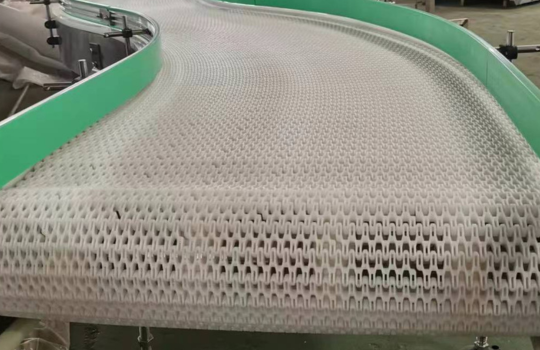Conveyor Belt Materials
Choosing the right conveyor belt material is critical for the efficiency and longevity of your conveyor system. Here are some common materials:
- PVC (Polyvinyl Chloride): Ideal for light-duty applications. It is lightweight, cost-effective, and resistant to chemicals and moisture.
- Rubber: Suited for heavy-duty tasks like mining and construction. It offers excellent durability and resistance to abrasions.
- Polyurethane (PU): Used in food and pharmaceutical industries due to its flexibility and resistance to oils and chemicals.
- Metal: Preferred for high-temperature environments and heavy loads. It is heat-resistant and highly durable.
- Modular belt :A modular belt is conveyor belt made up of interlocking, segmented pieces, typically constructed from durable plastic. These segments snap together to form a continuous belt that can be customized to fit different widths and lengths, making them highly versatile for various applications. main material :POM ,PE ,PP and PA .
Advantages of Modular Belt Materials
- Durability: Resistant to wear and tear, ensuring long service life.
- Hygiene: Easy to clean, making them suitable for food and pharmaceutical industries.
- Customizability: Interlocking segments can be tailored to specific needs.
- Chemical Resistance: Withstands exposure to various chemicals, extending usability in harsh environments.

.
Conveyor Belt Specifications
Understanding conveyor belt specifications ensures the selection of the right belt for your application. Key specifications include:
- Belt Material: Choose from PVC, rubber, PU, metal, fabric, or silicone based on your needs.
- Belt Width: Typically ranges from 20 mm to over 2000 mm.
- Belt Thickness: Generally between 1 mm and 30 mm.
- Load Capacity: Measured in kg/m, indicating the maximum weight the belt can handle.
- Operating Speed: Measured in m/s or fpm, representing the belt’s movement speed.
- Temperature Range: Indicates the operating temperature limits of the belt.
- Tensile Strength: The maximum stress the belt can withstand before breaking.
- Elongation: The percentage the belt can stretch under load.
- Surface Type: Options include smooth, rough, textured, or patterned surfaces.
- Edge Type: Sealed, cut, or molded edges affecting durability and maintenance.
Importance of Specifications
Matching Application Requirements
Selecting a belt with the correct specifications ensures that it meets the demands of your application, leading to better performance and longevity.
Ensuring Safety and Efficiency
Proper specifications help maintain safety standards and operational efficiency, reducing downtime and maintenance costs.
Optimizing Cost
Choosing the right specifications can optimize costs by avoiding over-specification (unnecessary features) or under-specification (leading to frequent replacements and failures).
Conveyor System Design
Designing an efficient conveyor system requires careful consideration of several factors:
- Application Requirements: Define the type and weight of materials to be transported.Consider the environment and conditions, such as temperature, humidity, and exposure to chemicals.
- Conveyor Type:Choose between flat belt conveyors, roller conveyors, modular conveyors, and others based on the application.
- Layout Design:Plan the conveyor path, including straight sections, curves, and inclines.Ensure there is adequate space for installation and maintenance.
- Drive System:Select the appropriate drive type, whether it’s a motorized drive, gravity, or manual operation.
- Safety Features:Incorporate safety guards, emergency stops, and other safety mechanisms to protect workers.
- Maintenance Access:Design the system for easy access to components for cleaning, inspection, and repairs.
- Customization:Customize the system to meet specific operational needs, such as adjustable speeds, modular sections, and specialized belts.

